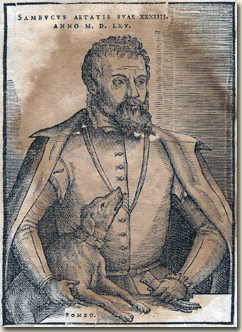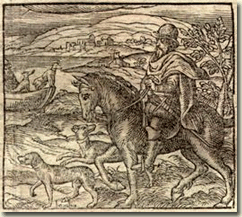Although historiae from Pliny
to Jerónimo Cortés register many examples of the faithfulness of
dogs, we actually only know a handful of their names. Perhaps
the only one that certainly springs to mind is Argos, the dog of Ulysses.
Even the impeccable Ravisius Textor managed to collect only a
dozen of them in the chapter of "Names of illustrious dogs" of
his Cornucopia, in contrast to the following
chapter, where he deluges us with more than fifty names of
illustrious horses.
This is why it is so peculiar to see
that Johannes Sambucus, in the second edition of his
Emblemata, portrays himself with his dog, and furthermore,
just as he bears the identifying inscription "Sambucus at the age
of 34, in the year 1565", so also the dog, looking up at
his master with an ineffably faithful glance, bears an
inscription indicating his name: "Bombo". So peculiar indeed,
that Joseph Heller, in his Geschichte der Holzschneidekunst
von den ältesten bis auf die neuesten Zeiten (Bamberg
1823), affirmed this name as the signature of the engraver,
thus creating ex nihilo a hitherto unknown Italian
artist.
However, if he had just advanced some
pages further, he would have found the bearer of the name in Emblem 126,
dedicated by Sambucus to his two dogs Bombo and Madel. (The
word "dedication" is perhaps to be taken seriously here, for
Sambucus usually dedicates his emblems in a subtitle to
friends and patrons, but this one, and the following one – describing the coat of arms of his native town
Nagyszombat (Tirnavia), thus in a sense "dedicated" to his
town – belong among the few exceptions.) This emblem is a token
of the deep friendship that bound Sambucus to his two dogs,
those animals that
who "followed him on sea and land everywhere"; the
pictura also represents them wandering together on
earth, while in the background, just sitting in a little boat,
the convivial threesome set out on some voyage on the sea. It is also peculiar that this author's
portrait only figures in this second edition (1566). Neither the first edition of 1564,
nor the following ones
of 1569, 1576 and 1584 – as well as the Dutch and French translations
of 1566 and 1567, all published with Plantin – bear it; they
all display a
more traditional author's bust in an oval frame, and without
any companion. Both the format and the date of the 1566
portrait suggest that in this year Sambucus, at the age of
thirty-four, returning home after a peregrination of
twenty-two years studying all over Europe – the stations of
which are mentioned in the emblem quoted – and establishing
himself in
Vienna as the court physician of Emperor Maximilian, had a
portrait painted to commemorate this way of life.
And for this portrait he must have considered it important to sit together with
the most faithful companion of his life, Bombo. The
painted portrait has since then perished, just like the
persons represented on it. But the engraved copy has survived
to erect a monument to their firm friendship, aere
perennius.
To our humanist friends
Károly and Burkus.
|
| |

Portrait of Johannes Sambucus
in the second edition
of his Emblemata
(1566) Johannes Sambucus, Emblemata, Antwerp 1584 (fifth, definitive ed.)
Emblema 126: Fidei canum exemplum

SIT quanta odori vis canis,
Et quae fides erga suos
Heros, monere quos vides
Possunt mei canes duo,
Bombo cui nomen dedi,
Matri & Madel simillimae.
Hi me sequuntur per mare,
Terras per, & cunctos locos.
Lutetia hoc frequens tulit,
Videre Romam nescij,
Νεάν τε καὶ καλὴν πόλιν
Et Teutonae terrae procul
Partem quae habetur optima.
Belgas peragrarunt simul,
Ducentur & spero breui
Dulcem in vocantem & patriam.
Merentur hi famam canes.
Sensus inesse cur neges
His bestiis sequacibus? (Emblem 126:
The dog is an example of faithfulness. – How great is the sense of
smell of the dog, and how faithful it is to its master, can be
learned in my two dogs that you see here, the one to whom I gave the
name Bombo, and Madel, both similar to their mother. They have
followed me on land and sea everywhere. Paris has often hosted
them, and they have seen – albeit ignorantly – Rome, and the new and
beautiful city [Νεὰν
πόλιν = Naples]; and the
excellent province that is near to Germany; they have also wandered
through together Belgium. And I hope they will be taken within a short time
to my sweet homeland [Hungary], which is calling us. These dogs do
merit their fame. Why, then, would you deny these companions
have reason inside?) Ravisius Textor, Cornucopiae epitome, Lyon 1560, pp. 358-359, cap. "Canum quorundam nomina" (Names
of some [illustrious] dogs)
Gargitius canis fuit, Cerberi Epirotici frater, qui Geryonis
tricorporis seruabat armenta. Hunc Hercules unà cum domino
interfecit. Incolae mortuo sepulcrum erexerunt.
Graucis, nomen est catellae, qua Arethusa absentis mariti
desiderium solabatur. Prop. lib. 4. Graucidos & catulae uox est mihi
grata querentis, &c.
Issa nomen est catellae, quam Publius habuit in deliciis.
Martialis: Issa est passere nequior Catulli: Issa est purior osculo
columbae: Issa est blandior omnibus puellis: Issa est charior
Indicis lapillis: Issa est deliciae catella Publi.
Apud historicos legitur Perses, fuisse catellus filiae
Aemilij Pauli.
Chiron, Canis fuit Codri poëtae pauperrimi. Iuuenalis: Et
recubans sub eodem marmore Chiron.
Mera, canis fuit Icarij patris Erigones, cuius ductu Erigone
ipsa cadauer patris ab agrestibus interfecti reperit.
Durides, canis fuit Lysimachi, qui accenso domini rogo
iniecit se flammae. Autore Plinio lib. 8.
Atalanta, Arcadica uenatrix, canem habuit Auram nomine, quam
quum interfecisset aper Calydonius, sepulcro ab indigenis ornata
est.
Fuit Hippocentaurus canis Xenophontis.
Lethargus Hippammonis, qui etiam cum mortuo domino tumulatus
est.
Agrus [correctamente: Argus] canis fuit Vlyssis, qui reuersum ab expeditione Troiana dominum post annos uiginti fertur agnouisse. |